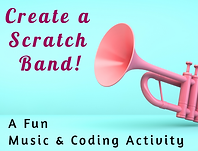.jpeg)
David E. Thomascall, PhD
Spark a love of STEM with exciting, ready-made lessons and activities.
Check out my article in STEM Magazine
Check me out on social media or email me at STEMbits@gmail.com

Beats and Bytes: Teaching Music and Coding Together
Known as the first computer programmer, Ada Lovelace was a true visionary. She believed computers could be more than just calculators; they could be tools for expressing creativity and exploring the world around us. She even imagined them composing complex and beautiful music. This isn't so surprising when you realize how much music and coding share in common. Both music and coding have their own unique languages, each with specific rules and structures. In music, there are notes, scales, and rhythms; in coding, there are conditionals, loops, and syntax. Just as a musician creates a song by arranging notes and phrases, a coder builds a program by organizing functions and lines of code. Sequencing is vital in both, whether it’s the order of musical notes or the flow of commands in a program.

COLLABORATION
When music and technology teachers join forces, amazing things can happen in the classroom. Together, they can design lessons that let students explore music composition with code, create interactive sound experiences, and learn about the history of music technology. This kind of collaboration not only boosts students' musical and technical skills but also encourages creative problem-solving and cross-curricular thinking.
Song Maker
Music and coding are two worlds that may seem far apart, but tools like Chrome Music Lab’s Song Maker show just how beautifully they can come together. Song Maker allows students to turn simple dots into melodies, blending creativity with technology in an engaging and accessible way. Whether they’re crafting tunes, solving musical puzzles, or exploring how patterns translate into sound, students discover the shared language of music and coding. These hands-on activities brings these disciplines together, sparking curiosity and creativity in your classroom.
Binary Beats
Music is all around us—from the tunes that wake us up to the playlists that keep us going throughout the day. But have you ever wondered how your favorite songs go from vibrant sound waves to the binary magic of 1s and 0s that your devices can read? In this activity, we’ll dive into the fascinating process of digitizing sound, turning music into data. Along the way, we’ll get hands-on with Chrome Music Lab’s Song Maker, a fun and interactive tool where you can compose melodies, explore binary code.
Music Boxes
Imagine a world without digital music players or streaming services. Instead, music comes from a tiny box that tinkles with a crank of a handle. That's the magic of the music box, a centuries-old invention that continues to charm listeners of all ages. But beyond the delightful melodies, music boxes hold a surprising secret: a connection to the history of technology. This activity will unlock the inner workings of these fascinating instruments, explore their unexpected link to the past, and let you code a song on a music box.
Scratch Band
Music and coding might seem like an unlikely duo, but they share a lot in common—both are built on patterns, sequencing, and creativity. This activity blends these two disciplines into an engaging project for students: creating a Scratch band. Using Scratch, a beginner-friendly coding platform, students can compose melodies, program animations, and design their own virtual performances. Along the way, they’ll discover how coding and music work together, developing computational thinking, collaboration skills, and a deeper appreciation for both art and technology.








